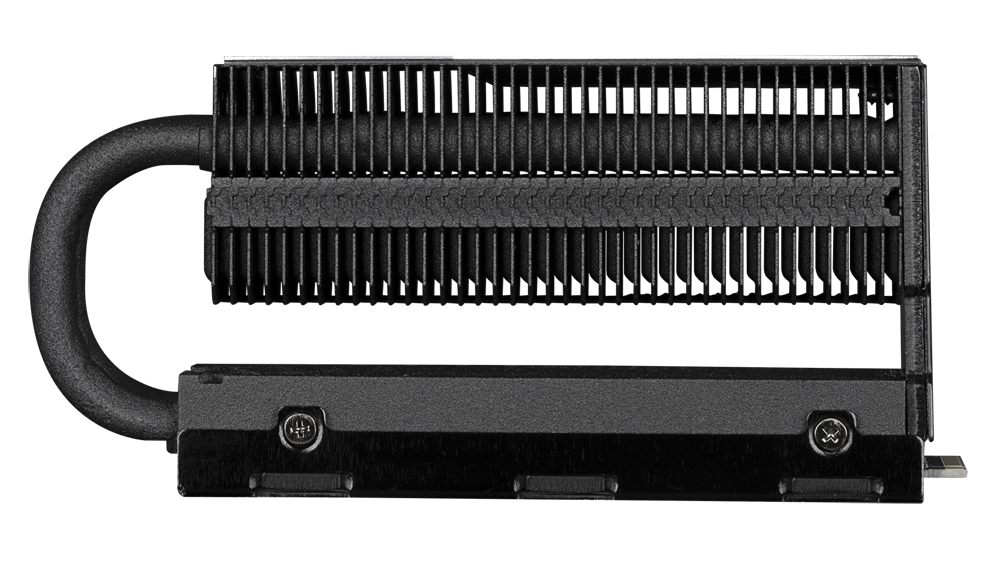Gigabyte's New Gen 4 M.2 SSD Promises 7GBps Speeds All Day Long
Goodbye thermal throttling, hello clearance concerns.
Gigabyte's latest Aorus SSD promises to eliminate thermal throttling and deliver extremely fast read speeds of up to 7GBps. The drive is called the Aorus 7000s Prem., and it comes with a gigantic black heatsink measuring up to 1.76 inches (44.7mm) in height, to ensure the drive stays cool under long-duration reads and writes.


The 7000s Prem. is basically identical in most ways to the standard Aorus 7000s solid-state drive that we found competitive with the best SSDs when we reviewed it. Both feature a second-generation Phison E18 8 channel controller, AES-256 encryption support, 3D TLC NAND, and a DDR4 DRAM cache. But with the 7000s Prem., you’re getting that big beefy heatsink to improve performance.
The heatsink itself is called the M.2 Thermal Guard Xtreme and features a dual-heatpipe design, a nanocarbon coating, and an aluminum M.2 baseplate to help cool the bottom part of the drive. All in all, this heatsink is just as large as some aftermarket M.2 heatsinks you can add onto your current M.2 SSDs, so performance should be excellent.

With Gigabyte’s internal testing, the Aorus 7000s Prem. performed at its max read speed of up to 7GBps (7000MBps) consistently for over 8 hours of time, with no signs of slowing down. But just remember that this is Gigabyte’s internal testing and results could change if your chassis can’t supply enough airflow to the heatsink or you live in a hot ambient environment.
The biggest consideration when purchasing this SSD will be its size; many motherboards these days won’t have the necessary headroom for the SSD and its associated heatsink--at least not on all the M.2 slots. Many M.2 slots are located either behind the motherboard or right underneath your graphics card, so make sure you check the location of your PCIe 4.0 M.2 slot to see if you have enough clearance for the heatsink.
The 7000s Prem. will come in 1TB and 2TB flavors. Both capacities feature the same 7GB/s read speeds, however, the write speeds change from 5500MB/s on the 1TB to 6850MB/s on the 2TB model. Pricing and availability for the 7000 Prem. is unknown at this time. But given that the standard model sells for about $380, sans that honking heatsink, it's a safe bet you'll be looking at spending close to $500 for those precious sustained speeds.
Get Tom's Hardware's best news and in-depth reviews, straight to your inbox.

Aaron Klotz is a contributing writer for Tom’s Hardware, covering news related to computer hardware such as CPUs, and graphics cards.
-
logainofhades Sadly, I couldn't use this, as my chipset fan is attached to the heatsink that covers my M.2 slot.Reply -
autobahn Sounds like the right long term thing to do is have thermal sensors in the SSD then PC builders can just add 3rd party coolers to their NVMe and get aggressive as they want with cooling.Reply -
jpe1701 Reply
They already do have sensors for that.autobahn said:Sounds like the right long term thing to do is have thermal sensors in the SSD then PC builders can just add 3rd party coolers to their NVMe and get aggressive as they want with cooling. -
watzupken That is if you can even fit that giant SSD heatsink without obstructions in the first place. For high end systems sporting high end graphic cards utilizing air cooling, a cooler this tall is going to be problematic.Reply -
smithy566 Good luck trying to fit that in a PS5. The temp of these high performance drives must be the root cause of the delay in Sony supporting these, surely?Reply